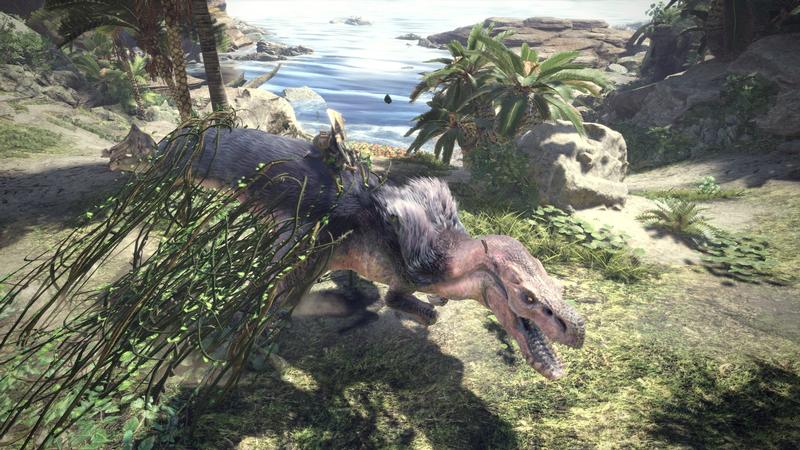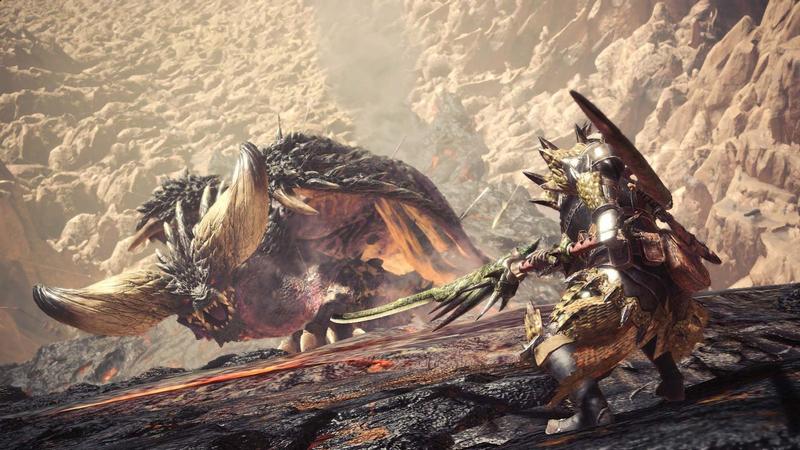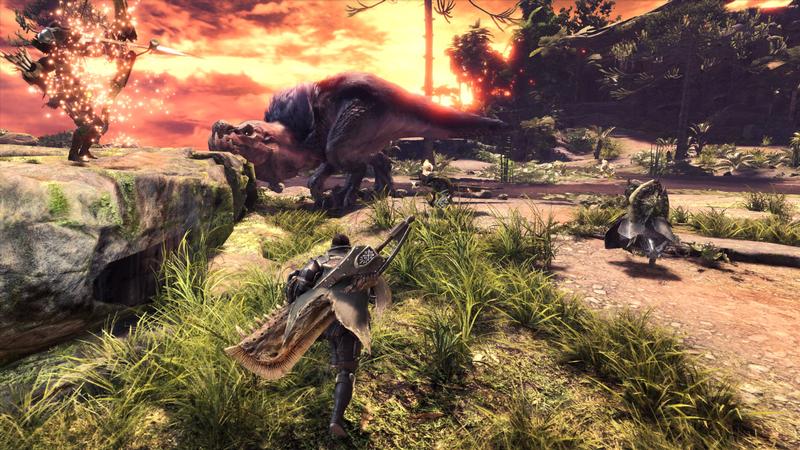But here’s the thing: I’m, at a stretch, a Monster Hunter veteran. I’ve been playing it for years and years on PSP and then on 3DS. This is the first time it’s globally made its way onto consoles, and the first time I’ve felt as though there’s been a real effort to make it appeal to the masses in the UK and the US (it is enormous in Japan). While I absolutely love Monster Hunter games, I have no idea how it’s going to go down with those new to the franchise. It’s one of the most complex games I’ve ever played, with 14 weapon types to master, hundreds and hundreds of items to learn the uses of, huge numbers of weapons and armour to craft with varying strengths, weaknesses and elements, and that’s just the tip of the iceberg. It’s taken me years to learn it all, and I’m still far from an expert at it. Plus, Monster Hunter: World, despite its name, isn’t an open world game. Instead, you have timed quests that take place in various different maps. You’ll be limited to very basic quests to begin with, in order to help you get the items you’ll need to upgrade your first weapons and armour sets. Quests get progressively more difficult as you upgrade your equipment and learn new skills, until you find yourself fighting weird and wonderful monsters so tough they’ll kill you in one hit even with the strongest of armour. To make this review as well-rounded as possible, we decided to get a total Monster Hunter newbie (Games Editor Lewis Painter) to play too. That way, whether you’re new to the game or not, you should get an idea about whether or not you’re going to enjoy it. We’ve combined our star ratings for a final rating, but carry on reading to find out our (differing) opinions and split verdicts. (We’ve not mentioned multiplayer much as we haven’t had a chance to use it pre-launch, but we’ll use it over the weekend and will update this early next week!). Oh, and if you’re struggling, take a look at our top Monster Hunter: World tips and tricks. Also check out the new Monster Hunter World Iceborne expansion.
Monster Hunter: World UK pricing and availability
Monster Hunter: World Review – New vs Experienced players
As mentioned above, the experience between those that know the franchise and those trying it for the first time are quite different, and to help illustrate this, we’ve split the review into two – one for experienced players (by Ashleigh), and one for new players (by Lewis).
Experienced players
There’s a lot about Monster Hunter: World that will feel familiar to long-standing players, but everything feels as though it’s been kicked up a notch. The power of the console means there are no more loading screens between areas – you’ll be able to roam the maps freely. That does also mean there’s no more escaping into another area to heal and sharpen, though. The maps are more complex than before, too. They’re layered this time around, and feature various camps that you’ll need to discover that act as fast travel points when travelling to and from the area for Quests. This is especially handy if you already know where the monster will be, as you can cut down the amount of time spent tracking. Gathering points and other areas of interest are now marked on your map as you discover them, too, providing an invaluable resource when on quests and expeditions. You can have cats, or Palicos, as they’re officially named, cook you a meal from the camp itself before each quest, bringing a range of ability boosts that stay with you for the entire quest, or until you faint. You’re now able to switch weapons mid-quest too, as long as you prepare your storage box properly first. All 14 weapons from Monster Hunter Generations are still available, though there are some notable changes. There are too many to run through completely, but for me, the best change is that your Kinsect is treated separately from the Glaive with the Insect Glaive weapons. This means that you can upgrade your Kinsect safe in the knowledge that you can switch it between weapons when necessary. Another change is the removal of Hunter Arts, which I must admit I’m pleased about because I found them to be an unnecessarily complex. Instead, there are plenty of weapon-specific combos, which you can master in training areas or as you progress through the quests themselves.
Something else I love about Monster Hunter: World is that single and multiplayer quests are now a single entity. You can team up with up with three other players on every quest in the game, rather than having to treat the single player quests differently to those that contribute to your Hunter Rank in multiplayer mode. Plus, if you’re struggling to take down a particularly challenging beast on your own, you can send for help (without ending the quest) using the new SOS feature. Simply fire a flare and all other Hunters in your online session will be notified of your request. You can also play private games with just those you invite, or with players from around the world. I have a big group of friends that all play Monster Hunter, so we tend to play in private groups of four, taking it in turns to choose a quest that could help us get items need for weapons and armour. Another thing that’s new and incredibly helpful is the Wishlist feature. In previous games, I’d have a notebook with weapon trees and armour sets scrawled in it, trying desperately to keep track of items I needed and how many I already had. Now, with the wishlist feature, that’s all taken care of for you, so you can spend more time actually gathering the items rather than trying to work out which you need. In the previous Monster Hunter game on 3DS (Monster Hunter Generations), there was a Prowler mode that let you play quests as your Palico. That’s gone in Monster Hunter: World, but the felines can still join you on your quests to provide backup when there aren’t four people in your party. We’ve got this far and haven’t even mentioned the monsters! Their improvements are the most exciting, I think. In addition to there being some cool-looking new monsters to fight and learn about, there’s also much more interaction between monsters. The beauty of the open world nature of the game means that it’s possible that two monsters will bump into each other randomly and fight to the death. This completely changes the dynamic of the battle (to your advantage OR disadvantage) and provides an epic view if nothing else. You shouldn’t worry too much about time either – if you’ve not got long left of your quest and haven’t quite finished killing the monster you need to when a new, even more exciting monster appears, you can continue killing the original monster to end the quest then choose to stay in the area to kill the monster that appeared. This new feature is called Expedition mode and can be accessed whenever not in a quest.
New players
While the game is welcoming for long-time fans of the series, those (like me, Lewis Painter) that are fresh to the series may struggle – especially when it comes to learning the ropes. That’s because Monster Hunter: World is massive and complex; it uses mechanics and systems from previous games along with new features, and assumes you have knowledge of how these systems work before you jump into the game. That’s not to say that there aren’t any tutorials though. The first hour of the game is essentially a tutorial, introducing you to the concept of the game and the most important areas in your camp. The issue is that it doesn’t really address combat – one of the biggest parts of the game, and arguably one of the most complex. There are 14 types of weapon, each with upgrade trees and a range of different abilities and effects, and you’re left to hack at barrels in a training area with minimal combat prompts to find out how to best utilise each weapon. C’mon Capcom, if it’s a training area, at least let me train against something remotely like what I’ll be facing in the wild! For example, there’s a cool weapon called a Switch Axe that switches between an axe and a sword with some kind of special ammo (despite firing no bullets) – it looks cool and I imagine it could do a fair bit of damage, but I couldn’t tell you how best to use it or what the ammo is used for because the game assumes I already know. The assumption of prior knowledge is the game’s biggest downfall, but if you’re dedicated and up for learning the intricate systems at play, you’ll be rewarded with the freedom to take on Monsters however you like. That’s the upside to complex systems – the game is incredibly versatile in terms of gameplay. You can hide in bushes and use crossbows to deal damage from afar, go all-in close-range with a longsword or act a little more defensive with a sword and shield combo. You can focus your armour on melee defence or specialise in elemental protection – you can even tweak your Palico’s loadout to compliment your play style.
The combat button mappings are somewhat confusing too, especially if you’re used to the standard R1/R2 combo for light and heavy attacks. Firstly, the button combinations depend on the weapon you’re using, and secondly, R2 is usually reserved for a special move that requires some powering up – not good for those that revert to bashing R2 out of habit. It’s not the only questionable choice either – tapping either R1 or Square during combat will put your weapon away, something that would happen to me constantly when trying to recall the complex weapon combos from the training area. These two buttons are, in most other games, used for combat, and muscle memory means I’ve put my weapon away on more than one occasion and started sharpening my blade while directly in front of a monster. It’s frustrating while you’re learning and takes some time to get used to. While Quests are the aim of the game, I’ve come to prefer going on Expeditions during my time in Monster Hunter: World. I find that the time limit on Quests – though hidden by default – to add unnecessary pressure to a task that is already fairly difficult, and although the time is usually more than enough, I’d prefer being able to go at my leisure. And that’s why Expeditions are great; you can explore the different biomes you come across with no limit on time or deaths, and you’re free to explore, scavenge and take on Monsters at your heart’s content. The only difference is that unlike with completed quests, you won’t receive any special rewards on return to camp. A huge part of the game is multiplayer gameplay, where online players can join you on expeditions, give you backup when taking on Quest monsters and more. The issue is that there aren’t many people online right now, so we can’t really try it out. I’ll be playing this weekend with others, so I’ll update this next week with more information. Essentially, if you’re a newcomer, expect to put some serious hours into Monster Hunter: World and be up for learning the ins and outs of the games intricate systems and mechanics. It’s not a casual game that you can jump into for 20 minutes either, as most Monsters will take longer than that to kill – and that’s not including time taken to track them down! There’s definitely enough bang for its buck to be appealing, but we just wish that there was a little more hand-holding in the first couple of hours while you’re still learning – and that’s not something I thought I’d ever say about a game.



